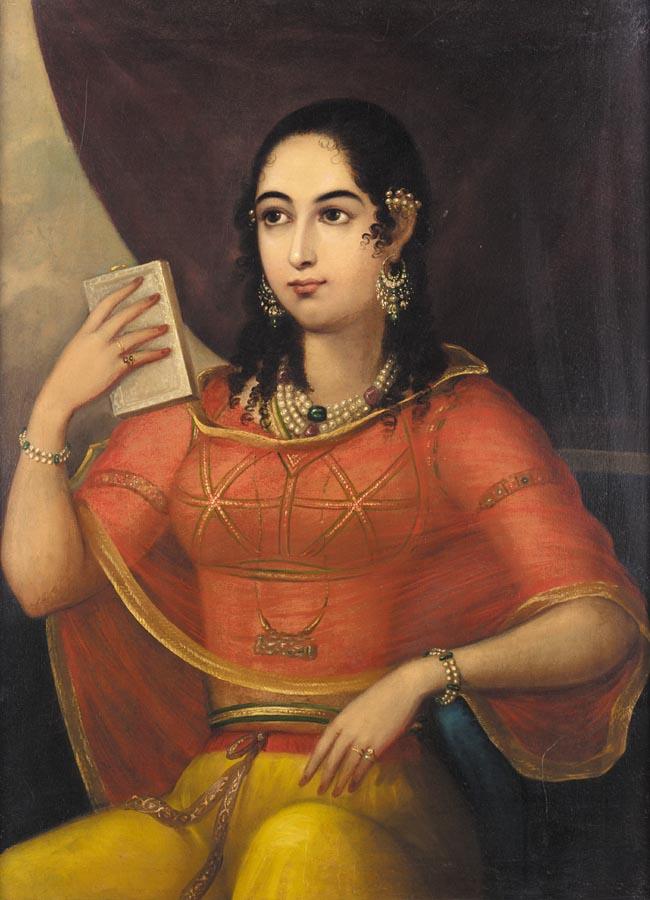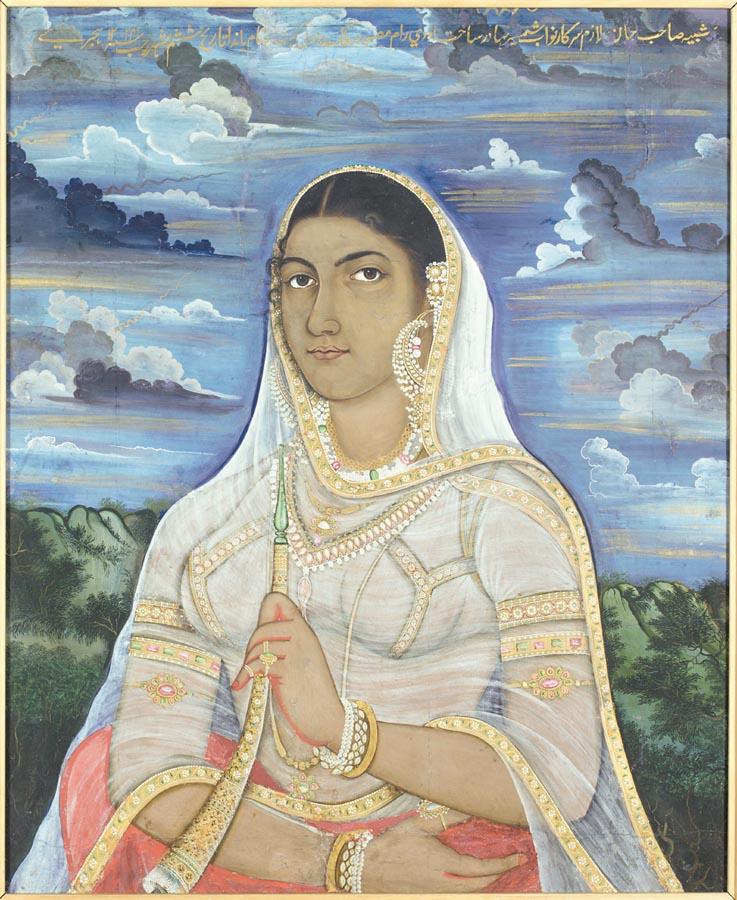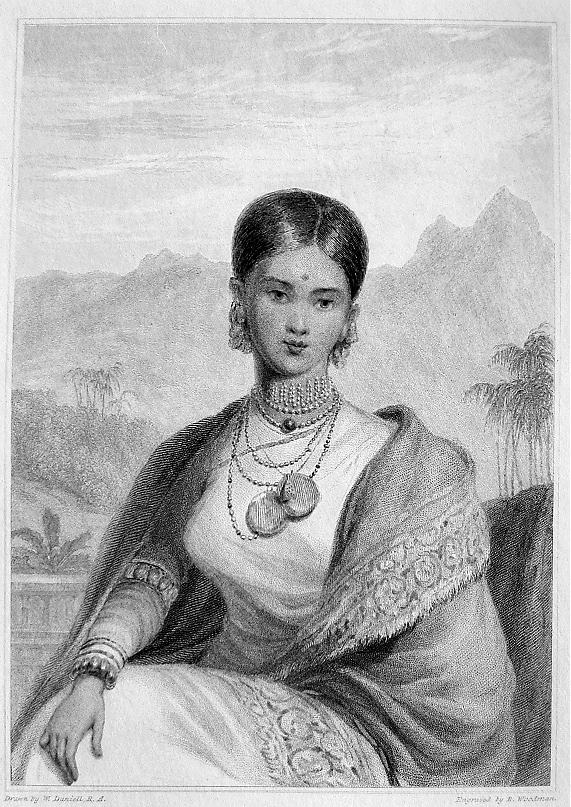

"Portrait of a Bibi, Lucknow," possibly by Zoffany, c.1785
Source:
http://search.sothebys.com/jsps/live/lot/LotDetail.jsp?lot_id=4FGN9
(downloaded May 2005)
" A PORTRAIT OF A BIBI, LUCKNOW, INDIA, SECOND HALF 18TH CENTURY; oil on canvas, framed. CATALOGUE NOTE: inscriptions: on the reverse in English "Attrb to J.Zoffany 1785 Jehan [?] of ... Lucknow 1785"
She sits in an interior before a draped curtain, with a cloudy sky visible beyond. Her hair hangs in ringlets around her sweet face, her ears and neck heavy with opulent jewellery. One arm is raised and she clasps a delicately carved jade mirror in her hand, although her eyes gaze guilelessly into the distance. Whilst the actual identity of the sitter is difficult to establish, with her rich, though informal, robes and splendid jewels it is likely that the subject of this charming portrait was the bibi of a British East India-man.
As a result of the strict customs governing the interaction of men and women in India, most artists' impressions of the fairer sex were drawn either from imagination or from the only visible group, the ubiquitous nautch girl, who entertained society by dancing in public. Such women were often of the lower echelons of the social hierarchy, and are unlikely to have been as fair or as voluptuous as this sitter. Nor would a nautch girl have owned such opulent jewellery, or be seated in a luxurious interior; it is probable therefore that a portrait of an elegant Indian lady of society would have been commissioned by a member of the Anglo-Indian community. This portrait represents both a novel development in the painting of women and also a new section of society itself, the bibis of the white mughals. Traditionally taboo portraits of women became not uncommon during the eighteenth century, as the tastes and cultural morés of the British were established in the Raj. In such paintings of newly 'visible' women, she is often painted indoors or in a gentrified landscape, and her countenance is imbued with a demureness, and composure that suggests a woman of breeding, as it is here.
As British society became ensconced in India, certain indigenous traditions were assimilated into Anglo-Indian protocol and so the keeping of one or, in some cases, more mistresses became accepted. Such notables as John Wombwell, William Hickey, Colonel Claud Martin, Sir Charles Ware Malet and Major William Palmer all commissioned paintings of their bibis, William Palmer even immortalised both his concurrent bibis and their children in a painting of his family by Francesco Renaldi (Archer 1979, no.196, p.282). Indeed, he married one of his bibis as declared in the Times of 19 February 1925 that announced the marriage of a "great-grandson of General Palmer and his Begum of Oudh." It is apparent from such historical documents that the bibi was more than just an amorous consort but that she fulfilled the role of wife, companion and mother. Indeed personal accounts from British men emphasise this fact in their reference to bibis in tender terms, William Hickey declared his bibi "as gentle and affectionately attached a girl as ever man was blessed with," and refers to his friend Colonel Cooper's bibi as "a beautiful Hindostanee woman to whom he was greatly attached."
This painting is likely to date prior to 1800, the year in which both private and official opinion began to turn against inter-racial marriage, and the British concept of cultural supremacy gained ground over an easy relationship between the two civilisations. This would appear to corroborate the date of 1785 inscribed on the rear of the original stretcher, however, it is unlikely to have been painted by Zoffany (a discussion of whom can be found in Archer 1979, pp130-178)."

Portrait of the courtesan Sahib Jan, August 1809
Source:
http://search.sothebys.com/jsps/live/lot/LotDetail.jsp?lot_id=4FGNC
(downloaded May 2005)
"A PORTRAIT OF THE COURTESAN SAHIB JAN, BANDA, BUNDELKAND, NORTH WEST INDIA, DATED 6 RAJAB 1224/17 AUGUST 1809; 81.2 by 66cm.; gouache on canvas, inscribed above in Urdu "The portrait of Sahib Jan the inseparable mistress of the Nawwab Shamsher Bahadur; by Uday Ram, the painter in the kingdom of Bundelkand, the site of Banda on 6 Rajab 1224 of the Hijra"
CATALOGUE NOTE: This monumental portrait of an Indian courtesan is an excellent example of the synthesis of European and Indian artistic genres and techniques. The woman is portrayed in life size, seated in three-quarter pose, her skin is shaded, her body modelled and she is framed against a background that suggests depth. These elements, drawn out of the European tradition of secular portraiture, are in sharp contrast with the small scale miniatures of tilted planes and conventionalised figures that are traditionally associated with painting in the Gwalior region. However, certain features recall more traditional Indian techniques; most prominently, the background, where lush vegetation and a dominant sky evoke both contemporary and earlier miniature series.
The portrait depicts the mistress of the Nawab Shamsher Bahadur. Shamsher Bahadur became the titular head of Banda, north of Gwalior, in 1804. He was the son of 'Ali Bahadur (d.1802), an illegitimate grandson of the last Maratha, Peshwa Baji Rao II."

== Indian Routes index == Indian Routes sitemap == Glossary == FWP's main page ==